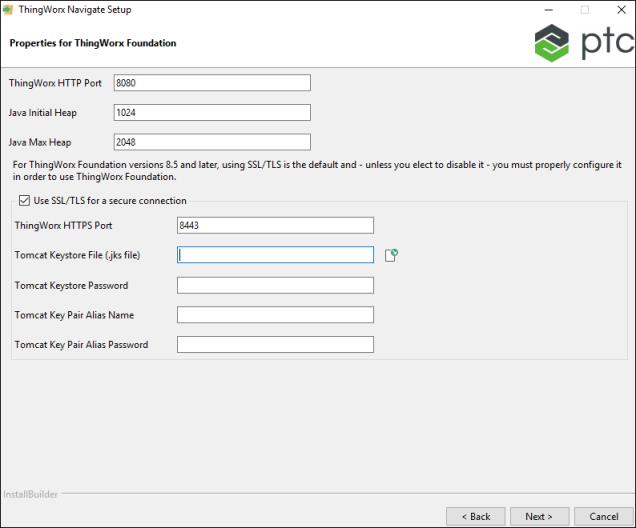Install ThingWorx Navigate
Let’s dive right in. Using the ThingWorx Navigate Setup installation tool, we’ll install ThingWorx Navigate and the other required software. In the sections below, you’ll find more information to help you set up your system.
Open the installation tool
According to the installation package that you downloaded, unzip the download and then open the installer file:
• Windows with Microsoft SQL—ThingworxNavigate-MSSQL-<version>-Windows-installer.exe
• Windows with PostgreSQL—ThingworxNavigate-Postgres-<version>-Windows-installer.exe
• Linux with Microsoft SQL—ThingworxNavigate-MSSQL-<version>-Linux-x64-installer.run
• Linux with PostgreSQL—ThingworxNavigate-Postgres-<version>-Linux-x64-installer.run
For Windows, double-click the file to open the ThingWorx Navigate Setup tool.
For Linux, make sure you run ThingWorx Navigate Setup with the root user.
Welcome to ThingWorx Navigate
Let’s begin with the installation for ThingWorx Navigate. Click Next to begin.
Getting ready to install
Now, a reminder to make sure that you meet all the prerequisites:
• System and software requirements
• Server information for the new Microsoft SQL or PostgreSQL database you created with an assigned owner. Refer to the
Prerequisites topic for details on database creation.
Click Next.
Applications in this installer
This installation tool helps you install all applications that are required to run ThingWorx Navigate:
• Apache Tomcat
• ThingWorx Foundation
• ThingWorx Navigate
• ThingWorx Integration Runtime
Click Next.
License agreement
1. Read the license agreement, and then select I accept the agreement. You can print a copy of the agreement.
2. Click Next.
Installation location
On the Installation Location page, decide where to install .
1. Next to
Path, click

to set a location, or accept the default location:
◦ Windows—C:\Program Files (x86)
◦ Linux—/opt
Make sure you install ThingWorx Navigate in a location that has at least 100 gigabytes of free disk space.
2. Click Next.
Set a ThingWorx Administrator user password
1. Set the password for your
ThingWorx Administrator account. Make sure the password is 14 to 28 characters long, that includes a mix of uppercase and lowercase letters, numbers, and symbols. Refer to the
User Passwords topic in the
ThingWorx Help for guidelines on setting a user password.
2. Click Next.
Properties for ThingWorx Foundation
Follow these steps to set up a connection with ThingWorx Foundation:
1. Provide ThingWorx HTTP Port. The default port is 8080. Supported ports range from 00 to 9999. Ensure the port you enter is not already used for any other installation.
2. In the fields for Java Initial Heap and Java Max Heap, accept default values of 1024 and 2048 respectively.
3. The Use SSL/TLS for a secure connection check box is selected by default to set up a secure connection. If you choose not to configure ThingWorx for SSL/TLS, clear the Use SSL/TLS for a secure connection check box, click Next, and skip to the “PostgreSQL Connection Information / Microsoft SQL Connection Information” section.
4. Before you enter the information in the next fields, make sure you prepare the correct Keystore and Key Pair files:
The topic
Set Up ThingWorx Navigate with SSL contains the instructions for generating Keystore files. In that topic, you’ll also find background information on the files and certificates associated with SSL/TLS.
Detailed background information is available in this technical support
article.
◦ Tomcat Keystore File (.jks file)—Create an Apache Tomcat SSL Keystore in the JKS format (*.jks) using the Java keytool command.
Now that your files are ready, you can provide the information required in the steps below.
5. In ThingWorx HTTPS Port, enter a port number. Make sure this is a different port than the ThingWorx HTTP Port.
6. Next to
Tomcat Keystore File, click

. Browse to the Keystore file you created in Step 4, and then click
OK.
7. Next to Tomcat Keystore Password, enter the password you defined when you created the Tomcat Keystore file.
8. Next to Tomcat Key Pair Alias Name, enter the alias name you gave when you created the Tomcat SSL Keystore file.
9. Next to Tomcat Key Pair Alias Password, provide the password of the Key Pair for the Tomcat SSL Keystore file.
| The information you provide here is entered in the JSON (*.json) file for ThingWorx Integration Runtime. The information is used to connect to ThingWorx when SSL/TLS is configured. |
10. Click Next.
Add connection information for PostgreSQL / Microsoft SQL
If you’re using Microsoft SQL, start with Step 1. For PostgreSQL, skip ahead to Step 2. Step 3 applies to both databases.
1. For MSSQL, enter the following connection information:
◦ IP Address or Host Name—Use a fully qualified host name
◦ Port number—The default is 1433
◦ Database Instance—This box is optional.
Then, skip to Step 3 to create the ThingWorx database schema information.
2. For PostgreSQL, enter the following connection information:
◦ IP Address or Host Name
◦ Port number—The default is 5432
3. For any database, enter the following information for your ThingWorx database schema.
◦ ThingWorx Database Name—Enter the name of the database you created as part of the prerequisites.
◦ Username—Enter the user name of the database owner you created.
◦ Password—Enter the password for the database owner you created.
4. Click Next.
Summary: Installation settings
Now’s the time to review your settings. If you need to change anything, click Back. When you’re ready, click Install.
The installation process can take several minutes.
Success!
ThingWorx Navigate is installed.
The next step is downloading and deploying your license. ThingWorx Navigate provides a tool to guide you through licensing. This tool will start automatically after you click Next on the Success! page.
Let’s move on to licensing. Click Next.


 to set a location, or accept the default location:
to set a location, or accept the default location: